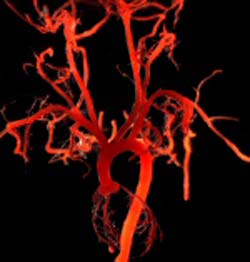Mutation in Mouse Circulatory Gene That Mimics A Form of Congenital Heart Disease

Mutations in a critical gene that controls heart and blood vessel development in mouse embryos mimics a type of congenital heart disease in humans, according to new research led by Michael S. Parmacek, MD, Director of the Penn Cardiovascular Institute at the University of Pennsylvania School of Medicine. Congenital heart disease (CHD) occurs in approximately one in one hundred newborn infants. Knowing the basic genetic causes of congenital heart disease will allow for the development of CHD prenatal diagnosis, as well as treatments to prevent or correct infant and adult heart disease.
Using genetically engineered mice, the researchers found that mice with a mutation in the gene for myocardin-related transcription factor B (MRTF-B) had defects in developing arteries associated with the embryonic heart. Specifically, these mice had a variation of a childhood condition known as a truncus arteriosis defect, a relatively rare form of CHD that occurs in infants in which the aorta does not appropriately separate from the pulmonary artery. (Click on thumbnail above to view full-size image). As a result, oxygenated and deoxygenated blood mix, resulting in insufficient amounts of oxygen being transported to tissues. This causes cyanosis, which is commonly referred to as “blue babies.” Senior author Parmacek and his colleagues published their findings in this week’s early online edition of the Proceedings of the National Academy of Sciences.
Using the gene itself as a marker, the researchers confirmed that the problems in the mouse blood vessels originated from defects in the cardiac neural crest cells, stem cells that migrate from regions of the brain to the heart in developing embryos. These cells populate the heart and eventually differentiate into the smooth muscle cells of the major blood vessels.
“When we looked at the embryonic heart and great arteries during early development in the mice, we saw a variety of defects in the major arteries, suggesting defective patterning of the newly formed blood vessels, including the pulmonary artery, the carotid artery, and the aorta,” notes Parmacek. “These were all consistent with the defects observed later on that caused the embryos not to survive after birth.”
Overall, the researchers demonstrated that the cardiac neural crest cells that originate in the brain do migrate to the heart and outflow tract areas; but, unlike in normal mice, the cells with mutations did not differentiate into smooth muscle cells. As a result, the cells did not form the structure that separates the aorta from the pulmonary artery. “This is the first evidence that a block in stem-cell differentiation is responsible for forms of congenital heart disease,” says Parmacek. “Understanding how MRTF-B works will let us see how this critical junction in the development of the circulatory system regulates how tissues unfold downstream.”
The study was funded in part by the National Institutes of Health. Penn study co-authors are Jian Li, Xiaohong Zhu, Mary Chen, Lan Cheng, Deying Zhou, MinMin Lu, Kevin Du, and Jonathan A. Epstein.
Media Contact
More Information:
http://www.uphs.upenn.eduAll latest news from the category: Life Sciences and Chemistry
Articles and reports from the Life Sciences and chemistry area deal with applied and basic research into modern biology, chemistry and human medicine.
Valuable information can be found on a range of life sciences fields including bacteriology, biochemistry, bionics, bioinformatics, biophysics, biotechnology, genetics, geobotany, human biology, marine biology, microbiology, molecular biology, cellular biology, zoology, bioinorganic chemistry, microchemistry and environmental chemistry.
Newest articles

Superradiant atoms could push the boundaries of how precisely time can be measured
Superradiant atoms can help us measure time more precisely than ever. In a new study, researchers from the University of Copenhagen present a new method for measuring the time interval,…

Ion thermoelectric conversion devices for near room temperature
The electrode sheet of the thermoelectric device consists of ionic hydrogel, which is sandwiched between the electrodes to form, and the Prussian blue on the electrode undergoes a redox reaction…

Zap Energy achieves 37-million-degree temperatures in a compact device
New publication reports record electron temperatures for a small-scale, sheared-flow-stabilized Z-pinch fusion device. In the nine decades since humans first produced fusion reactions, only a few fusion technologies have demonstrated…





















